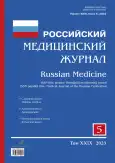Type 2 diabetes mellitus in combination with COVID-19: clinical and metabolic characteristics of patients and prediction of mortality risk
- Authors: Demicheva T.P.1
-
Affiliations:
- Perm State Medical University named after Academician E.A. Wagner
- Issue: Vol 29, No 5 (2023)
- Pages: 367-373
- Section: Original Research Articles
- URL: https://journals.rcsi.science/0869-2106/article/view/232002
- DOI: https://doi.org/10.17816/medjrf340852
- ID: 232002
Cite item
Abstract
BACKGROUND: In the context of the coronavirus pandemic, patients with diabetes are a special risk group. Diabetes mellitus aggravates the disease course. The characterization of comorbidities and the search for available mortality predictors is an urgent problem.
AIM: To assess the clinical and metabolic parameters of comorbidities and determine prognostically significant risk factors for the development of unfavorable outcomes.
MATERIAL AND METHODS: The study included 169 patients with type 2 diabetes mellitus and COVID-19. The patients were divided into two groups: the group 1 included patients who were discharged from the hospital (survivors; n=82), and the group 2 included those who died from COVID-19 (n=87). A comparative assessment of baseline clinical and metabolic parameters in patients of both groups was conducted, and their mortality risk factors were determined.
RESULTS: For several indicators, no statistically significant differences were found between the groups in terms of age, total cholesterol, activated partial thromboplastin time, and fibrinogen. Peculiarities were revealed for other indicators, such as the volume of lung tissue damage, level of oxygen saturation, fasting glycemia, leukocytes, alanine transaminase, aspartate aminotransferase, procalcitonin, ferritin, C-reactive protein, D-dimer, and lymphocytes. Factors that can rapidly predict the risk of death from COVID-19 in patients with type 2 diabetes included saturation <90.12%, area of lung damage >45.8%, and fasting glycemia >7 mmol/L.
CONCLUSION: The results obtained make it possible to assess the condition of patients with type 2 diabetes mellitus and COVID-19, and the identified risk factors of mortality allow the attending physician to form risk groups for patients, conduct constant monitoring, and provide individualized therapeutic measures.
Full Text
##article.viewOnOriginalSite##About the authors
Tatyana P. Demicheva
Perm State Medical University named after Academician E.A. Wagner
Author for correspondence.
Email: demich-perm@mail.ru
ORCID iD: 0000-0002-5422-8700
SPIN-code: 3743-3914
MD, Cand. Sci (Med.), associate professor
Russian Federation, 26 Petropavlovskaya street, 614990 PermReferences
- Singh AK, Gupta R, Ghosh A, Misra A. Diabetes in COVID-19: prevalence, pathophysiology, prognosis and practical considerations. Diabetes Metab Syndr. 2020;14(4):303–310. doi: 10.1016/j.dsx.2020.04.004
- Мarkova TN, Ponomareva AA, Samsonova IV, et al. Risk factors for fatal outcome in patients with type 2 diabetes mellitus and a new coronavirus infection. Endocrinology. News. Opinions. Training. 2022;11(1):8–16. (In Russ). doi: 10.33029/2304-9529-2022-11-1-8-16
- Huang I, Lim MA, Pranata R. Diabetes mellitus is associated with increased mortality and severity of disease in COVID-19 pneumonia — a systematic review, meta-analysis, and meta-regression. Diabetes Metab Syndr. 2020;14(4):395–403. doi: 10.1016/j.dsx.2020.04.018
- Вelikina DV, Nekrasova TA, Malysheva ES, et al. COVID-19 and diabetes mellitus: features of the course, outcomes, the role of inflammatory and glycemic disorders. Medical Almanac. 2021;(2): 33–40. (In Russ).
- Wu Z, McGoogan JM. Characteristics of and important lessons from the coronavirus disease 2019 (COVID-19) outbreak in China: summary of a report of 72314 cases from the Chinese Center for Disease Control and Prevention. JAMA. 2020;323(13):1239–1242. doi: 10.1001/jama.2020.2648
- Shestakova MV, Vikulova OK, Isakov MA, Dedov II. Diabetes and COVID-19: analysis of the clinical outcomes according to the data of the russian diabetes registry. Problems of Endocrinology. 2020;66(1):35–46. (In Russ). doi: 10.14341/probl12458
- Dedov II, Shestakova MV, Mayorov AYu, editors. Standards of specialized diabetes care. 10th edition (updated). Diabetes Mellitus. (In Russ). doi: 10.14341/DM12802
- Hussain A, Bhowmik B, do Vale Moreira NC. COVID-19 and diabetes: knowledge in progress. Diabetes Res Clin Pract. 2020;162:108–142. doi: 10.1016Zj.diabres.2020.108142
- Ilyas R, Wallis R, Soilleux EJ, et al. High glucose disrupts oligosaccharide recognition function via competitive inhibition: a potential mechanism for immune dysregulation in diabetes mellitus. Immunobiology. 2011;216(1-2):126–131. doi: 10.1016/j.imbio.2010.06.002
- Petrie JR, Guzik TJ, Touyz RM. Diabetes, hypertension, and cardiovascular disease: clinical insights and vascular mechanisms. Can J Cardiol. 2018;34(5):575–584. doi: 10.1016/j.cjca.2017.12.005
- Philips BJ, Meguer JX, Redman J, Baker EH. Factors determining the appearance of glucose in upper and lower respiratory tract secretions. Intensive Care Med. 2003;29(12):2204–2210. doi: 10.1007/s00134-003-1961-2
- Hill MA, Mantzoros C, Sowers JR. Commentary: COVID-19 in patients with diabetes. Metabolism. 2020;107:154217. doi: 10.1016/j.metabol.2020.154217
- Shi S, Qin M, Shen B, et al. Association of cardiac injury with mortality in hospitalized patients with COVID-19 in Wuhan, China. JAMA Cardiol. 2020;5(7):802–810. doi: 10.1001/jamacardio.2020.0950
- Patent RUS N 2783058 C1/11/8/2022. Demicheva TP. A method for rapid prediction of the risk of death in patients with type 2 diabetes mellitus in combination with a new coronavirus infection. (In Russ).
Supplementary files






